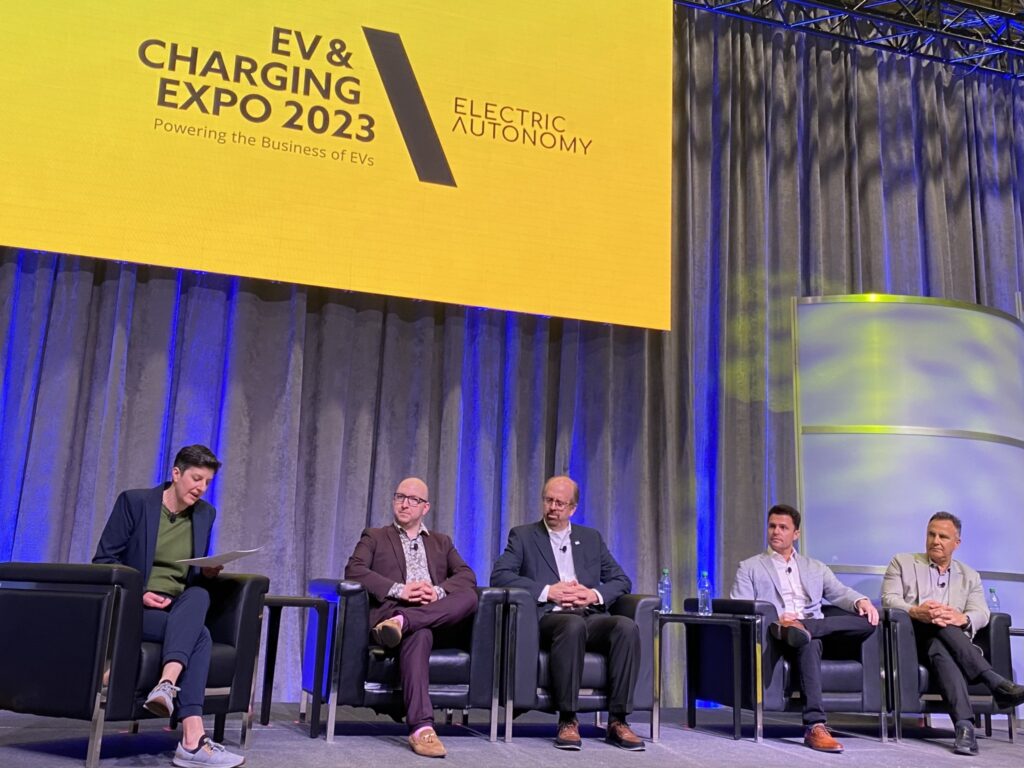Early electric trucks identify opportunities and limitations
Christopher Ralph, Lion Electric’s manager of client solutions and design, points directly to the price of diesel when describing one of the benefits of battery-electric trucks.
The price at the pump varies wildly, he observed during a panel discussion during the EV & Charging Expo in Toronto. “Electricity rates are regulated. I can tell you exactly what they’re going to be one year from now. I can tell you exactly what they’re going to be five years from now.”
Not only that, fleets also have the opportunity to turn charging infrastructure into a revenue stream, potentially feeding electricity back into the grid, he said.

The benefits of electrification don’t end there, of course.
“On the high level there’s policy mandates behind all of this,” Ralph stressed, adding that electric vehicles tick all the boxes for corporate environmental, social and governance (ESG) commitments.
‘A Class 6 truck can dominate’
Ralph even dismissed many concerns about operating ranges and charging times, noting that Amazon is currently running an electric Class 6 truck 20 hours a day.
“A Class 6 truck can dominate in an urban environment,” he said.
The very nature of many e-commerce packages make them a perfect fit for battery-electric box trucks, agreed Dave Schaller, industry engagement director at the North American Council for Freight Efficiency (NACFE). “The boxes are mostly air.”
Jonathan Polka, BYD North America’s director of business development – national fleets, referred to shunt trucks as another perfect fit for electrification. “If you high idle and just keep a diesel truck parked there, it’s going to problematic,” he said, referring to combustion-related maintenance needs that emerge in such applications.
The challenge and opportunity of hills
Other trucks face decidedly different challenges. Work trucks tend to be heavier than their package-toting counterparts, and some routes extend beyond the ranges associated with drayage and regional activity.
But early forays into electrification are identifying some opportunities to push the limits of vehicle range.
One of the trucks that participated in NACFE’s Run on Less Electric demonstration in 2021 generated 30% of its energy through regenerative braking, Schaller said as an example. “It was free energy gathered because Vancouver is hilly and you have to go downhill.” Using that model, a fleet may actually choose to charge truck batteries up to 70% of their maximum capacity and let gravity do the rest.
Dave Earle, president and CEO of the B.C. Trucking Association (BCTA), countered that his province presents unique challenges for electric vehicles because of factors such as heavier weights and the same hilly terrain.
In 2021, a B.C. carrier spent several weeks traveling between a Washington warehouse and Vancouver, covering a 240-km route. But it was only able to cover the hilly terrain because the loads were light.
“Grades are a big issue,” he said, adding that real-world electric vehicle ranges can also be 20 to 25% less than originally promised.
Jump in early
Still, Earle stressed the need to experiment with the options available today. “Jump in and jump in early,” he said. “Those organizations that take that step and step in early are going to win. You’re going to find what works, and you’re going to find out what the challenges are.”
Deciding exactly where to deploy early battery-electric trucks requires in-depth consultations between fleets and suppliers, however.
The discussions with fleets begin with a focus on duty cycles and payloads, Polka said, referring to the value of fitting existing trucks with data loggers to secure a better understanding of the distances and idle time that are involved.
“This isn’t writing a cheque and going to a dealer,” he added. “You don’t walk this path alone.”
A role for customers
Even shippers and their customers have a role to play.
Individual consumers are making greener choices in their buying decisions, Ralph suggested, noting that Canada Post already uses carbon offsets to provide customers the option of carbon-neutral deliveries.
But Earle said one of the barriers to electric vehicle investments involves shippers who focus on price alone.
“The biggest issue we see consistently is the commodification of transportation,” he said, referring to those who buy transportation services without caring whether the load is pulled by an aging diesel truck.
“Customers, citizens have to be engaged and talk to the people we deal with.”
Have your say
This is a moderated forum. Comments will no longer be published unless they are accompanied by a first and last name and a verifiable email address. (Today's Trucking will not publish or share the email address.) Profane language and content deemed to be libelous, racist, or threatening in nature will not be published under any circumstances.
HILLS AND COLD WORST ENNEMIES OF THE ELECTRIC VEHICULES FOR NOW AND MANY YEARS TO COME